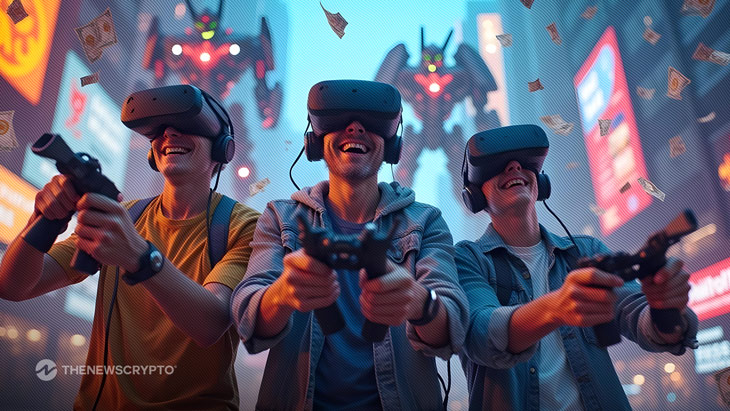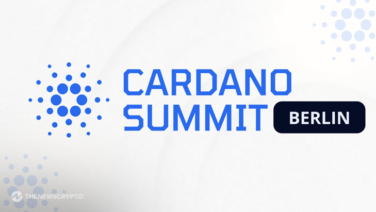- Crypto gaming blends traditional gaming with cryptocurrency, allowing players to earn, trade, and cash out in-game assets.
- Blockchain enables the creation and management of in-game assets as NFTs, ensuring true ownership and uniqueness.
Blockchain technology has revolutionized the gaming industry, giving birth to play-to-earn (P2E) models and ushering in new opportunities for gamers. These inventions are completely revolutionizing the best way video games are made and played, in addition to the economic guidelines of the gaming ecosystem.
This article focuses on the role of cryptocurrency in gaming – including important stats, how crypto gaming works, notable platforms, and advantages, challenges, and the future of blockchain in gaming.
The Rise of Crypto in Gaming
The most revolutionary aspect of the blockchain is the decentralized systems that allow true ownership of in-game assets, security of transactions, and new economic models. The worldwide market of blockchain games valued at approximately $4.6 billion in 2022 and is estimates to be around $65.7 billion by 2027, growing at a compound annual growth rate (CAGR) of 70.3% during this period.
Surging investment in blockchain games and the growing significance of P2E models are driving this fast growth.
Blockchain and Play-to-Earn Models: The Web3 Gaming Revolution
Web3 gaming is built on blockchain technology, enabling decentralized gaming experiences with genuine asset ownership. Unlike conventional Web2 gaming, where all assets always exist inside the game ecosystem, players in Web3 games possess as well as trade and monetize their in-game items on multiple platforms.
For this reason, the P2E model allows players to earn cryptocurrency or non-fungible tokens (NFTs) by playing the games and, in a way, to convert a hobby into money.
User Activity Surges in Blockchain Gaming
DappRadar is a popular analytics platform that monitors and provides insights into decentralized applications (dApps) across various blockchain networks. Furthermore, it tracks user activity, transaction volume, and even interactions with the smart contract, and these include DeFi, NFTs, and blockchain gaming.
Key Features of DappRadar:
- Tracks dApps across multiple blockchains.
- Provides real-time data on user activity, volume, and transactions.
- Ranks dApps based on performance and engagement.
DappRadar represents the historical activity in blockchain gaming over the past year. Here’s what it indicates:
UAW (Unique Active Wallets) (White Line): It represents the number of unique blockchain wallets interacting with gaming dApps.
Volume (Blue Bars & Right Y-Axis): It shows the transaction volume for blockchain gaming, probably in USD or native crypto.
Trend Analysis:
The activity in blockchain gaming gradually increased from February to January. Those spikes in UAW appear in late June, mid-October, and December, suggesting high engagement around those dates. Also, its volume is a low but oscillating one that has spikes about it, reflecting high values of transactions.
Key Observations:
The rise in UAW indicates that more people are getting into the blockchain gaming sector as blockchain gaming can compensate for their gameplay. UAW trends could note lower-value transactions or market stability, as volume holds below. The market seems to hold up even with significant spots in the late of Q4 or start of Q1 probably due to new game releases or seasonal trends.
How Does Crypto Gaming Work?
Blockchain technology is the main tool through which crypto games develop and govern their in-game assets as unique, non-liable NFTs. Players can win those while playing games or buy them through various marketplaces.
Also, smart contracts allow for safe and transparent transactions; therefore, players can exchange or sell their assets without mediators. Further, cryptocurrencies serve as in-game currencies, allowing players to earn, spend, or exchange them for other digital currencies or fiat money.
Cryptocurrency as In-Game Currency
The crypto gaming sector has seen significant growth, with many crypto games developing their in-game currencies. Significantly, the Gaming (GameFi) market cap stays at $14.7 billion, as of February 7, 2025. Here are some of the major crypto-gaming tokens:
Immutable (IMX): Immutable zkEVM, powered by Polygon, sets the gold standard for Ethereum scaling, combining Polygon’s cutting-edge zero-knowledge proof technology with Immutable’s focus on gaming and digital asset ownership.
Axie Infinity (AXS): Axie Infinity is the first blockchain game from Vietnamese studio Sky Mavis. In the game, Axies are bred and battled with. Also, these players earn in-game tokens, which they can trade or sell as non-fungible tokens.
Beam (BEAM): Beam is a privacy-oriented cryptocurrency that uses the Mimblewimble protocol to secure transactions. In addition, Beam is used in the Beam gaming ecosystem as the base token to facilitate engagement and transactions between NEAT wallets, including the transfer of in-game assets and interactions with smart contracts.
Gala (GALA): Gala Games is a blockchain gaming platform that empowers players by giving them true ownership of in-game assets through non-fungible tokens. Additionally, it allows players to buy in-game items and enables transactions between participants. Gala Games is trying to decentralize the gaming experience.
Ronin (RON): Ronin is an EVM-based blockchain focused on gaming-specific applications. However, with Ronin, Ethereum scalability problems are circumvented through almost-instant transactions at minimal fees and, thereby placing it at an advantage for heavy-demand gaming use cases, making it strong within the Web3 gaming arena as well.
The Sandbox (SAND): The Sandbox is a decentralized virtual gaming platform built on the Ethereum blockchain, allowing users to create, own, and monetize their gaming experiences by using non-fungible tokens. Moreover, a player can design, trade digital assets, participate in games, and engage in a player-driven economy.
The blockchain gaming landscape features several trending games that capture the attention of players and investors alike.
The Games to Notice:
Pixels: it is leading in daily on-chain activity and Pixels has seen a resurgence in its player base, making it the most popular blockchain game in terms of daily engagement.
Splinterlands: A digital trading card game that offers true ownership of cards through NFTs, strategic gameplay, and a thriving secondary market.
Axie Infinity: Players gather, breed, and fight fantasy creatures called Axies, which can potentially earn cryptocurrency; it is a pioneering sort of play-to-earn model.
Alien Worlds: A decentralized metaverse where gamers can mine, own land, and participate in governance, essentially fusing game playing with the elements of DeFi.
Upland: Virtual property trading, a game based on real-world mapping, with players buying, selling, and trading virtual properties, earning them in-game currencies with real value.
Blockchain Technology’s Benefits in Gaming
The blockchain technology provides the following benefits in the gaming industry:
True Ownership: Players can prove ownership of their in-game assets, which they can sell or transfer outside of the game.
Transparency: All transactions are recorded on a public ledger, thereby reducing fraud risk and ensuring fairness.
Interoperability: Assets can be used across games and platforms to create a unified gaming ecosystem.
Monetization: The game brings real-world value through gameplay participation and engagement.
Concerns About Implementing Blockchain in Gaming
Despite its benefits, integrating blockchain into gaming presents several challenges:
Scalability: Handling a large number of transactions can be challenging for some blockchain networks, potentially leading to slower transaction times and higher fees.
Regulatory Uncertainty: This constantly evolving legal landscape concerning cryptocurrencies and NFTs leaves much room for ambiguity between developers and players.
Environmental Impact: Some blockchain networks have a huge power consumption, so there is growing concern about the environmental impact.
User Adoption: Primarily, mainstream gamers may have fears or scepticism or simply remain unfamiliar with blockchain-based games.
Pros and Cons of Crypto Gaming:
Pros:
- Economic Opportunities: Players can earn income through gameplay.
- Enhanced Security: Blockchain’s decentralized nature reduces the risk of hacking and fraud.
- Community Governance: A few games let users participate in decentralized autonomous organizations or DAOs for decision-making processes.
Cons:
- Volatility: In-game cryptocurrencies and assets can change in value considerably.
- Complexity: New players may find the concepts of blockchain and crypto gaming challenging to understand.
- Regulatory Risks: Changes in laws and regulations can impact the viability of crypto games.
How to Get Started with Crypto Gaming:
- Educate Yourself: Learn about blockchain technology, cryptocurrencies, and NFTs.
- Choose a Game: Select a recognized crypto game that piques your interest.
- Set Up a Digital Wallet: Create a wallet to store your cryptocurrencies and NFTs.
- Acquire Cryptocurrency: Purchase the necessary cryptocurrency to participate in the game.
- Start Playing: Engage with the game, earn assets, and explore it.








